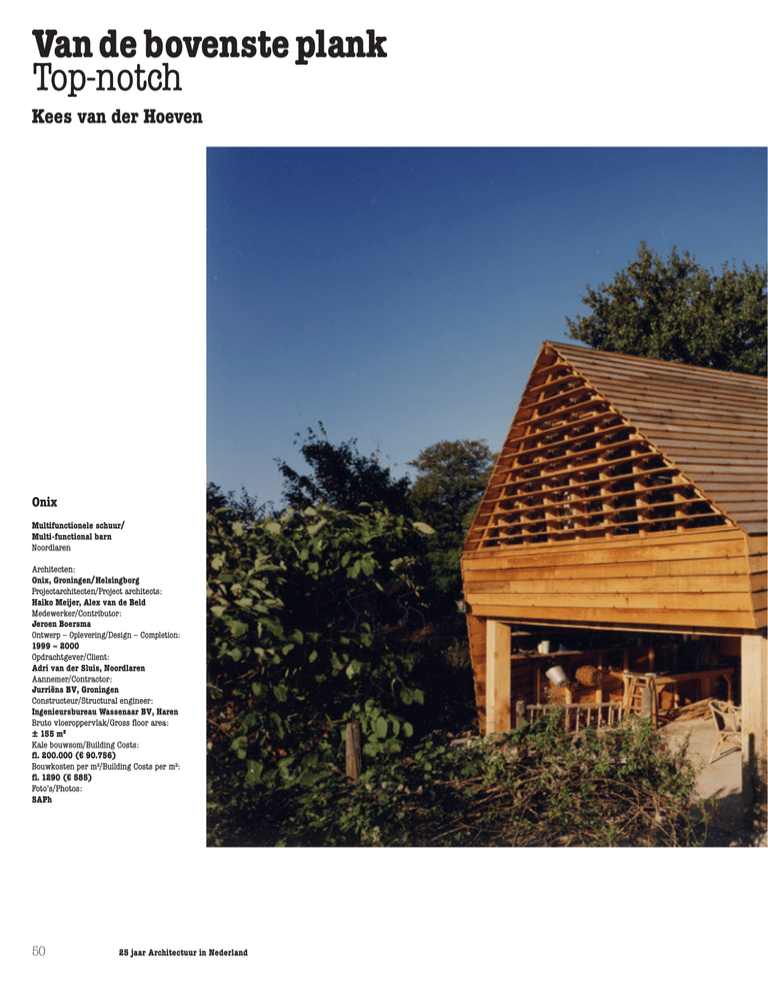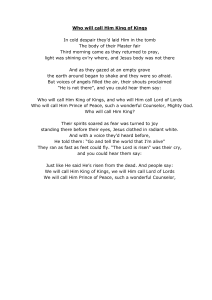ode - ArchitectenWerk
advertisement

Van de bovenste plank Top-notch Kees van der Hoeven Onix Multifunctionele schuur/ Multi-functional barn Noordlaren Architecten: Onix, Groningen/Helsingborg Projectarchitecten/Project architects: Haiko Meijer, Alex van de Beld Medewerker/Contributor: Jeroen Boersma Ontwerp – Oplevering/Design – Completion: 1999 – 2000 Opdrachtgever/Client: Adri van der Sluis, Noordlaren Aannemer/Contractor: Jurriëns BV, Groningen Constructeur/Structural engineer: Ingenieursbureau Wassenaar BV, Haren Bruto vloeroppervlak/Gross floor area: ± 155 m2 Kale bouwsom/Building Costs: fl. 200.000 (€ 90.756) Bouwkosten per m2/Building Costs per m2: fl. 1290 (€ 585) Foto’s/Photos: SAPh 50 25 jaar Architectuur in Nederland Hoe beschrijf je het moment waarop je een kunst­ werk onder ogen krijgt dat je leven ingrijpend ver­ andert? Hoe kan tekst overbrengen wat er dan gebeurt? Sommigen komen er dichtbij, zoals kunst­ historicus Henk van Os die een eerste ontmoeting met Red, White and Brown van Mark Rothko onder woorden brengt: ‘(...) het was alsof je door het schilderij werd geabsorbeerd. (...) Nog nooit had ik mij zo sterk gerealiseerd wat ik bovenal in kunst zocht. Nu wist ik het wel: opgaan in een ver­ heven stilte. Ontkomen aan jezelf in sublieme rust.’ Een eerste foto van de schuur van Onix, een bescheiden bijgebouw op het erf van een woonboer­ derij op het Groningse platteland, werkte ­precies omgekeerd. De energie van het beeld stroomde razendsnel binnen en brandde zich op het netvlies om er nooit meer vanuit te vertrekken. Je ziet een houten schuur die zonder woorden vertelt wat het verschijnsel schuur inhoudt. Die alle ­schuren bevat die je eerder hebt gezien en die on the spot de onuitwisbare referentie wordt voor alle schuren die je nog zult tegenkomen. Architectuur in één oog­ opslag verteld: als nut en noodzaak, als materiaal, als detail, als ambacht, als beeld, als ruimte, als gedachte, als een dat alles omvattend vak. Vanzelfsprekend hebben architectuurcritici het werk van architecten Alex van de Beld en Haiko Meijer van het Groningse Onix beschreven en met woorden geprobeerd het een passende plaats te geven in onze architectuurtraditie. Ze verwezen meestal naar het beroemde essay van Kenneth Frampton uit 1983 waarin hij het ‘kritisch regio­ nalisme’ uiteenzet. Hij probeerde zo een groeiende, breed samengestelde groep architecten te duiden die de uitwassen van de (vooral stedelijke) moderniteit bestreden, maar die niet gemakzuchtig terugvielen op traditionele of nostalgische archi­ How do you describe the moment when you see an artwork that dramatically changes your life? How can the written word convey what is going on at that moment? Some come close, like Dutch art historian Henk van Os in describing his first encounter with Mark Rothko’s Red, White and Brown: ‘...it was like being absorbed by the painting. ...Never before had I realized so acutely what it was I sought in art above all else. Now I knew: to be absorbed into an exalted stillness. To get away from oneself in sublime peace and quiet.’ An early photograph of Onix’s barn, a modest little outbuilding in the grounds of a converted farm­ house in the Groningen countryside, had precisely the opposite effect. The energy from the image was like a bolt from the blue, etching itself into memory, never to be erased. You see a wooden barn that wordlessly conveys what the phenomenon barn signifies. That contains all the barns you have ever seen and that becomes on the spot the indelible reference for every barn you will ever see from now on. Architecture summed up in a single glance: as purpose, as material, as detail, as craft, as image, as space, as idea, as a ‘container’ of all these things. It goes without saying that architecture critics have written about the work of architects Alex van de Beld and Haiko Meijer of the Groningen firm Onix, and have tried with words to assign it an appropriate place in our architectural tradition. They usually refer to the famous 1983 essay by Kenneth Frampton, in which he expounded the concept of ‘critical regionalism’. He was trying to characterize a growing, diverse group of architects who were opposed to the excrescences of (predominantly urban) modernism, but who did not simply fall back on traditional or nostalgic architecture. Instead, they produced innovative work through a synthesis of the modern 25 years of Architecture in the Netherlands 51 tectuur. Zij brachten juist vernieuwend werk door een synthese van het moderne met de traditie, met extra aandacht en gevoeligheid voor de specifieke kenmerken van de plek (genius loci). Roemer van Toorn poogde in 2007 Framptons visie dichter bij houding en werk van Onix te bren­ gen in zijn essay ‘Dirty Regionalism. The Perfect Imperfection of Onix Architects’. Eerder had Onix namelijk – naar analogie met het manifest Dogme 95 van een groep cineasten rond Lars von Trier – hun eigen ‘Dogmemanifest’ over architectuur op papier gezet. Waarin het experiment, het intensieve gesprek met gebruikers en makers en de imperfectie van ruwe en onaffe (‘vuile’) materialen een promi­ nente rol spelen. Vooral Van de Beld schrijft vaker teksten voor Onix, maar ook hun eigen nieuwe begrippen als ‘scenius loci’ en of ‘vreemd vertrou­ wen’ blijven te abstract om het gebouwde werk afdoende te beschrijven. Misschien is de duiding van hun architectonische kracht wel eenvoudiger gelegen in de persoonlijke geschiedenis van de architecten: beiden geboren, getogen en diep geworteld in het Fries-Groningse platteland en na hun hts-diploma opgeleid aan de meest noordelijke Academie van Bouwkunst. Van de Beld werkte toen als rechterhand van Jurjen van der Meer (nu De Zwarte Hond) en Meijer was de ‘linkerhand’ van Gunnar Daan. Uiterst vak­ kundige architecten, maar ook de wat ‘stuggere kerels’, die de architectuur in het vaderlandse Noorden, samen met bijvoorbeeld Cor Kalfsbeek (later Daad) in de afgelopen decennia een heel eigen gezicht hebben gegeven. Hilde de Haan beschrijft in het boek Woodworks Onix aanvullend nog hun voorliefde voor de deconstructivisten tijdens hun academiestudie en het gezamenlijke afstudeerproces. En dan met de Concept multifunctionele schuur/ Concept multi-functional barn and tradition, with special attention and sensitivity to the specific characteristics of the site (genius loci). In 2007 Roemer van Toorn attempted to bring Frampton’s view closer to the attitude and work of Onix in his essay ‘Dirty Regionalism. The Perfect Imperfection of Onix Architects’. It so happened that Onix – by analogy with the Dogme 95 manifesto issued by a group of film makers around Lars von Trier – had recently published its own ‘Dogme manifesto’, in which the experiment, the intensive conversation with users and makers and the imper­ fection of rough and unfinished (‘dirty’) materials played an important role. Van de Beld in particular often writes texts for Onix, but even their own new concepts such as ‘scenius loci’ or ‘strange familiarity’ are too abstract to adequately describe their built work. Perhaps the explanation of their architectural strength lies more simply in the architects’ personal history: both born, raised and deeply rooted in the Frisian-Groningen countryside and after gaining their technical school diplomas educated at the most northerly Academy of Architecture. Van de Beld subsequently worked as the right hand of Jurjen van der Meer (nowadays De Zwarte Hond) while Meijer was the ‘left hand’ of Gunnar Daan. Extremely skilful architects, but also the somewhat ‘sterner fellows’ who, together with Cor Kalfsbeek (later Daad), have given architecture in the country’s north a very distinctive visual identity in recent decades. Additional information is provided by Hilde de Haan in Woodworks Onix, where she describes their preference for the Deconstructivists during their studies and their joint master’s project. Then, with the clay still sticking to their boots, they set up an architectural practice together, searching for new meaning based on craftsmanship and working at Doorsneden/Sections 5 Begane grond/Ground floor 1 overdekt terras/covered terrace 2 berging/storage 3 carport 4 badkamer/bathroom 5 modeatelier/fashion studio 1 52 25 jaar Architectuur in Nederland Situatie/Site plan A woonhuis/house B schuur/barn C boerderij/farm D dorpsrand/ village border B C A D 2 1 3 4 klei nog aan de laarzen samen een architecten­ bureau beginnen, zoeken naar nieuwe betekenis vanuit het ambacht en werken aan een herkenbare positie binnen het vak. Ten slotte de multifunctionele schuur zelf. De opdrachtgever wilde een atelier aan huis voor zijn stadse kledingbedrijf, het bestemmingsplan liet een volière, carport, berging en erfscheiding toe. Onix combineerde alle functies in één volume, logisch geplaatst op de achtergebleven betonnen vloer voor het kuilvoer. Vier eiken spanten met daaroverheen twee langsbalken, drie ruimtes daartussen, de buitenste twee deels open maar overdekt. Een dichte wand naar het noorden als erfscheiding en het atelier onder een sporenkap op de verdieping, met een buitentrap waarvan de eerste trede uitnodigend is verlengd. De nok van het houten dak niet over de volle hoogte door­ lopend, anders werd het volume te groot volgens de regels. Dus een geknikte bovenste plank als boveneinde van het dakvlak, waardoor de kap meteen uniek wordt in zijn soort. En dan komt het: de driehoekige kopgevel van de kap aan de west­ zijde is subtiel naar voren gekanteld, loodrecht op de scheve nok. Gecombineerd met de schuine betimmering van de langsgevel biedt het beeld ons nu in perspectief de deconstructivistische draai: een virtuele scheefstand, alsof de schuur langzaam wegzakt in de aarde. Hij vertelt ons zo dat hij er altijd al stond en ook nooit meer weggaat – meester­­lijk. establishing a distinct position within the profession. Finally, the multi-functional barn itself. The client wanted a home-atelier for his city clothing firm, the zoning plan allowed an aviary, carport, shed and boundary fence. Onix incorporated all the functions in a single volume, logically situated on the old concrete floor of the silage silo. Four oak trusses topped by two longitudinal beams, three spaces between them, the outer two partially open but covered. A blank, north-facing wall as boundary wall, and the atelier under a rafter roof on the upper floor, with an external stair whose first step is invitingly extended. The ridge beam of the timber roof does not continue over the full height because then the volume would have exceeded the allowable size. Thus an angled capping plank as top end of the roof area, immediately making the roof unique of its kind. And then it happens: the western triangular gable end of the roof is subtly canted forwards, perpendicular to the sloping ridge. Combined with the sloping boarding of the long elevation, the image now reveals in perspective the deconstructivist twist: a virtual lopsidedness, as if the barn is gradually sinking into the ground. It is telling us that it has always stood here and that it will never go away – masterly. 25 years of Architecture in the Netherlands 53

